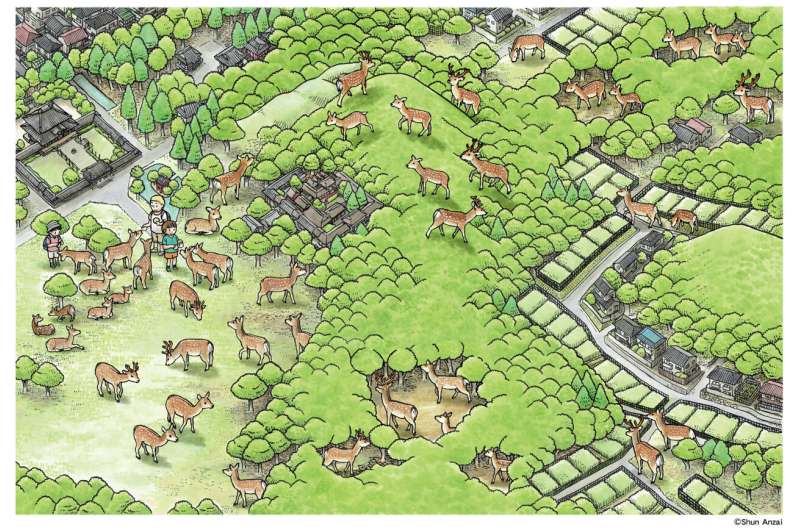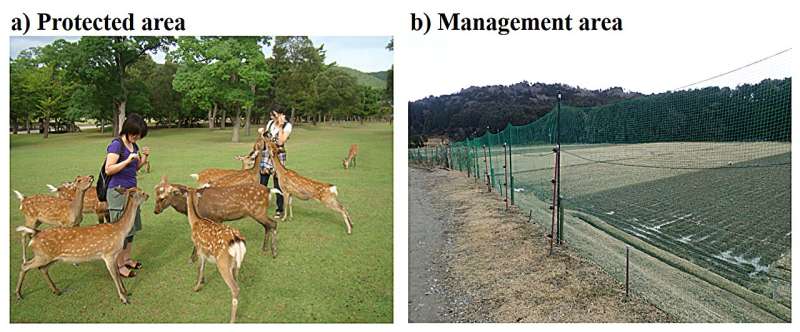This article has been reviewed according to Science X's editorial process and policies. Editors have highlighted the following attributes while ensuring the content's credibility:
fact-checked
proofread
Research provides genetic insights into Nara's sacred deer while exploring conservation challenges

In a world where human activities have left an indelible mark on ecosystems, the preservation of species and natural landscapes has become an urgent global concern. Despite such trends, Traditional taboos rooted in religious beliefs have sometimes served as influential mechanisms for species conservation.
Sociocultural systems have established sacred natural sites as an asylum with their rich biodiversity. Yet, research on species within these sites unveils conflicts between societal values and the imperative for nature conservation.
The case of Nara in Japan, where the sacred sika deer have been protected for over a thousand years, illustrates the complexities of wildlife management under cultural protection. Initially, the deer population was confined within traditional sanctuaries, but over 50 years of intensive protection policies have led to a rapid increase in numbers, causing them to spill out of these areas.
Additionally, in the last 20 years, deer populations have surged in surrounding regions, previously almost devoid of deer. These include deer born outside the sanctuaries, now encroaching on the traditional protected areas.
For local farmers, preventing agricultural damage caused by these increasing numbers is a significant challenge. However, legal constraints and psychological resistance make culling, a common approach in other regions, difficult to implement in Nara.
As this delicate balance between traditional protection and modern livelihoods is tested, the city of Nara has implemented wildlife management strategies, dividing the Nara city into protected, management, and buffer areas. Despite these efforts, however, the escalating deer population has persisted, demanding a more scientific approach and a comprehensive plan to deal with the growing deer population.
In response to this pressing issue, researchers from Fukushima University undertook a genetic study and delved into the intricate genetic composition of the sacred deer population.
"Our primary objective was to unveil potential impacts on the distinct genetic identity of the sacred deer, offering crucial insights that extend beyond genetics. The broader implication of the study was to explore wildlife management challenges and address overarching conservation issues," explains Associate Professor Shingo Kaneko from the Faculty of Symbiotic Systems Science, Fukushima University, who, along with his colleague Dr. Toshihito Takagi and their team conducted the study.
Their findings were published in Conservation Science and Practice.

The team started by collecting samples from nine sites in districts A, B, and D of Nara city, comprising a total of 165 deer specimens. Genetic analysis focusing on the mitochondrial DNA (mtDNA) control region and nuclear simple sequence repeat (SSR) markers revealed a spatial pattern in the distribution of genetic variations among the studied deer populations. In the protected area, there was a dominance of a single mtDNA haplotype labeled as S4.
However, in the management area, there were multiple haplotypes.
In terms of nuclear SSR, higher genetic diversity was observed in the management area compared to that in the protected region. The genetic structure and admixture analysis revealed two distinct clusters, with Cluster 1 dominant in the protected area and Cluster 1 and 2 mixed in the management region.
"The protected region, dominated by the exclusive S4 mtDNA haplotype, reflects their historical isolation. In contrast, the management area showcases the establishment of genetically distinct populations, suggesting interbreeding and the potential replacement of the sacred deer by ordinary deer," observes Dr. Takagi.
The coexistence and admixture context present challenges in deciding conservation policies, posing a dilemma between preserving the sacred deer lineage and allowing admixture to avoid extermination.
The urgency in addressing these conflicts is underscored by concerns such as increased damage to agriculture, loss of genetic specificity, and potential disease spread. The study emphasizes the need for reconciliation and agreement on values among stakeholders based on scientific analysis, considering broader socio-economic, ecological, and cultural conditions.
Public health concerns, including zoonosis and tick-borne diseases, further highlight the importance of careful management in this unique context, where the conservation of a population with a millennium-long history is at stake.
"Until now, research results from population genetic analysis have rarely been utilized in the Japanese wildlife management field. However, with the publication of our genetic research on 'Deer of Nara,' which is familiar to Japanese people, genetic analysis will likely be widely used to evaluate the origin of animals of unknown origin and the admixture of populations," states Dr. Kaneko.
The findings of this study will not only inform conservation and management strategies for Nara's sacred deer but also contribute to a global dialogue on balancing human-wildlife interactions in the face of rapid environmental changes.
More information: Toshihito Takagi et al, The sacred deer conflict of management after a 1000‐year history: Hunting in the name of conservation or loss of their genetic identity, Conservation Science and Practice (2024). DOI: 10.1111/csp2.13084
Provided by Fukushima University




















